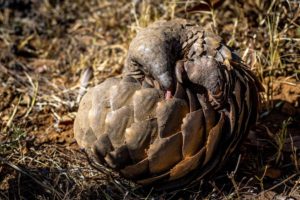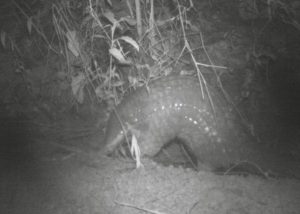By Sonim Kasar
 Pangolins?! “Where would you even find one these days? Maybe just the scales, if you’re lucky,” an old man mutters, half-laughing at the memory. His grandchild, wide-eyed, chimes in: “I’ve never seen a pangolin. Only heard stories, and about how much their scales sell for.” Another elderly, leans on her walking stick and recalls a time when pangolins wandered freely. “They used to be everywhere. I’d spot them right behind my house,” she says, her voice tinged with something between nostalgia and disbelief. Others speak more bluntly: “They fetch good money.” “Some say they bring luck.” “They’re hard to find now.” These passing remarks, tossed out over shared meals or village gatherings, pointed towards concern.
Pangolins?! “Where would you even find one these days? Maybe just the scales, if you’re lucky,” an old man mutters, half-laughing at the memory. His grandchild, wide-eyed, chimes in: “I’ve never seen a pangolin. Only heard stories, and about how much their scales sell for.” Another elderly, leans on her walking stick and recalls a time when pangolins wandered freely. “They used to be everywhere. I’d spot them right behind my house,” she says, her voice tinged with something between nostalgia and disbelief. Others speak more bluntly: “They fetch good money.” “Some say they bring luck.” “They’re hard to find now.” These passing remarks, tossed out over shared meals or village gatherings, pointed towards concern.
Out of sight, out of mind
Pangolins have slipped out of sight, not just physically, but culturally too. Where they were once part of the everyday landscape, they now live on as rumours, traded whispers, or symbols of lost fortune. For the older generation, pangolins were a familiar presence. For the young, they’re a mystery – creatures spoken of, but never seen. The story of the pangolin here isn’t just about a species disappearing from a landscape. It is about how a community’s relationship with a species has changed. Pangolins, over the past years, have drifted from the backyard to the black market.
There was a time when pangolins, locally known as the Sahung or Saham, roamed freely, scanning the undergrowth for ants and termites across the foothills of Mapithel in Chadong, Manipur. This was until the start of the Mapithel Multipurpose Project that promised hydroelectric power, irrigation and drinking water supply to the region. The project altered the course of the Thoubal River and reshaped the fragile ecology of Kamjong district. Additionally, years of unchecked poaching stripped the forests of their quiet, scaly residents. Today, sightings are rare. Occasionally, a farmer or a forager returns from the forest with a hushed account; a rustle in the leaves, claw marks on bark, a trail pressed into the soft mud – signs that might belong to the pangolin.
The search for the Saham
When the Wildlife Trust of India (WTI) installed camera traps in the area, villagers were doubtful. “You won’t find one,” they said, not out of scepticism, but with the heavy certainty of experience. Pangolins had vanished so thoroughly they’d become folklore. But the act of searching was an act of belief. It marked the beginning of a quiet mission under the initiative ‘Countering Pangolin Trafficking’, not just to confirm if the elusive animal still clung to the edges of the forest, but to rekindle a connection between the people and this vanishing species.
 Two days before the monsoon skies finally cleared, in May 2025, the team set out. Three local guides, one WTI staffer, and a determined sniffer dog named Boyka. They pushed through thickets along old hunting paths, the air still heavy with rain. After two hours of slow, deliberate searching, the group split up. With twilight setting in, the team still hadn’t found the right spot to place the camera. But just then, Boyka barked sharply, an urgent, rhythmic call that jolted the group. They ran toward him, hearts pounding.
Two days before the monsoon skies finally cleared, in May 2025, the team set out. Three local guides, one WTI staffer, and a determined sniffer dog named Boyka. They pushed through thickets along old hunting paths, the air still heavy with rain. After two hours of slow, deliberate searching, the group split up. With twilight setting in, the team still hadn’t found the right spot to place the camera. But just then, Boyka barked sharply, an urgent, rhythmic call that jolted the group. They ran toward him, hearts pounding.
There were fresh pangolin feeding burrows, scattered like clues in the damp soil. Boyka had led the team to a newly dug burrow. Spirits lifted, the team set up the camera immediately. Only later did they realise that the burrow belonged not to a pangolin, but to an Indian crested porcupine, nestled quietly inside. Fatigue weighed in, but the team left the camera behind, unwilling to give up entirely, and hiked back with a resolve to try again.
Then the rains returned, drenching the landscape and halting fieldwork for nearly a month.
The frame that was due
It wasn’t until June 2025 that the same team, this time without Boyka, retraced their steps. Through dense undergrowth and slippery trails, they reached the abandoned camera and retrieved it with little expectation. The long pause, the false lead, the silence of the forest, it all seemed to confirm what the villagers had warned. However, while scanning through the images, the expressions changed. There it was! A single photograph. Blurred slightly, but unmistakable. A Chinese pangolin. Its body coiled, its armour catching the light in overlapping scallops, like a creature carved from earth and memory. That one image was enough to change everything.
For the team, it was a vindication. For the villagers, it stirred much deeper, a flicker of wonder, a stir of pride. The pangolin was not a relic. It was real. Still here. Still fighting to survive in the margins of a changed world. For the landscape, too, a quiet awakening to revive its lost cultural and ecological roots with the species.
The camera trap photograph became more than a data point. It became a quiet rallying cry. A reason to believe in the power of looking closer, listening harder, and caring again. In Chadong, conservation took on a new meaning – not just protection, but remembrance. The pangolin had returned, not as a story or a shadow, but as a survivor.
And with it, hope.
(The author is a Field Officer, Countering Pangolin Trafficking Project, WTI)



